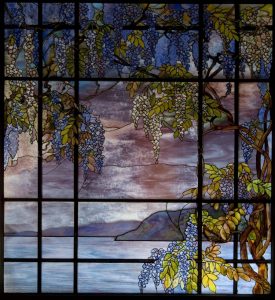It has long been called View of Oyster Bay, however, because the scene so closely resembles views from the north shore of Long Island, New York, where Tiffany built his grand country estate Laurelton Hall between 1902 and 1905. In 1978, Hugh and Jeannette McKean gave the loggia from Laurelton Hall to The Metropolitan Museum of Art in New York for installation in the light-filled space of the American Wing’s Charles Engelhard Court. At the same time, the McKeans made an extended loan of View of Oyster Bay to the Metropolitan. For almost thirty years, both the Laurelton Hall loggia and this masterfully crafted landscape window have been exhibited together and viewed by millions of appreciative visitors. Today, while the Metropolitan undertakes major renovations of the Charles Engelhard Court, we at the Morse are pleased to present View of Oyster Bay to our Winter Park visitors.
View of Oyster Bay is a particularly splendid example of the art and craft of Tiffany’s leaded glass. One looks through a trellis hung with lush, deeply-colored wisteria vines to a serene, sun-dappled bay and a glorious sky. The vines are resplendent with magnificent blue blossoms and intricately composed leaves in variegated greens and yellows. The heavy, black metal lines of the window’s trellis serve not only to hold the window together structurally, but also by their proportion and composition to stabilize the asymmetrical nature of the illusory three-dimensional space Tiffany has created with colored glass.
The lower portion of the view is the water of the bay itself. There light-blue glass yields at moments almost to white, brilliantly suggesting both the movement of the water and the effects of sunlight on it. Distant land masses are made of purplish glass, darker for the closest hill, paler for the more distant one. Reddish glass, variegated and gradated, suggests a darkening sky on the horizon behind the wisteria, while glass of the lightest purple-rose represents the fleeting sunlight at the furthest reaches beyond the hills.
Seldom do the elements of structure, color, texture, and composition come together in such balance and mutual support. It is no wonder that View of Oyster Bay is one of the most popular art objects exhibited at The Metropolitan Museum of Art in New York.



